MARTINA HINGIS: "THE SWISS MISS"

In 2005 Martina Hingis decided to make a come-back to professional tennis. Martina had walked away from tennis in 2002 after a career that saw her rise to number 1 in the rankings and stayed there for a total of 206 weeks. She captured 15 Grand Slam titles which included 5 singles, 9 women’s doubles, and 1 mixed doubles title. Martina Hingis burst on the tennis scene in 1993 she became the youngest player to win a Grand Slam ( The French Junior Singles) at only 13 years old Martina’s first match back was going to be the Pattaya Women’s Open, held annually in the seaside resort town of Pattaya, Thailand. The tournament is owned and run by an old friend of mine Geoffrey Rowe. Geoffrey has been running women’s events in Thailand for many years and Thai tennis owes him a huge debt of thanks. It was his wild card into the Pattaya Women’s Open that gave Tamarine Tanasugarn her big opportunity to break into the WTA Tour. Ironically “Tami” under-performed in Pattaya for ma



